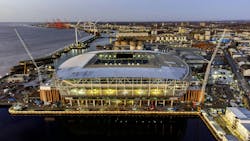Fourth-quarter sales and earnings fell at Fagerhult Group, but CEO Bodil Sonesson attributed the drop to the anomaly of a strong previous-year quarter. She said that robust orders — driven by renovation projects, fluorescent bans, energy savings, and smart lighting — bode well for business.
The declines of 7.1% in sales to 2.11 billion Swedish kronor (SEK; $202 million) from last year’s SEK 2.27 million, and of 36% in net profit to SEK 107.5 million ($10.2 million) from SEK 168.9 million for the quarter ending Dec. 31 did not stop 2023 year-end sales from besting those of 2022, although profits for the 12 months slipped.
For the year, sales for the Habo, Sweden–based LED lighting vendor were a company-record SEK 8.56 billion ($819.7 millon), up 3.5% from 2022’s SEK 8.27 billion, although the growth was virtually flat when adjusted for currency effects. Net profit for the year was SEK 543.7 million ($52.1 million), down 5.7%.
An upbeat Sonesson told analysts on a call this morning that the fourth-quarter sales decline reflected the unusual rush of business a year ago as pandemic-related supply chain constraints eased, making this year’s quarterly comparison “challenging.” The drop in profits related to both the sales performance and to one off-items that improved 2022’s fourth quarter, a spokesperson explained.
Sonesson said the real mark of fourth-quarter growth came from new orders, which rose by 8.1%, or 5.5% when adjusted for currency and business closures.
“We’ve been able to navigate a challenging financial landscape in a very positive way,” she told analysts. “We’re very positive about the continued strengthening of the order intake. Our strategic initiative, with a high focus on sustainability and smart lighting, to enhance our luminaire solutions and focus on renovation is clearly the right direction for us. We continue to strengthen our sustainable solution focus and and have high ambitions with regards to smart lighting.”
Renovation’s long reign
Sonesson outlined a future of strong long-term growth underpinned by the commercial market for renovating buildings into more energy-efficient ones and to replace fluorescent lighting that the E.U. now bans on a new sales basis for hazardous substance reasons (mercury).
Reinforcing that trend, users are slowly waking up to the added energy benefits of smart lighting in which sensors and occupancy data keep lighting at minimum levels, potentially raising what she said is LED’s 70% gain in energy efficiency to 90%.
The E.U.’s December revision of the Energy Performance of Buildings Directive will buttress the take-up of smart lighting, as it requires lighting to communicate with other building systems, she noted. Energy savings has emerged as key to Fagerhult’s IoT lighting push.
Illustrating the growth potential, Sonesson claimed that only around 4–5% of Europe’s buildings have been renovated, and many customers are only now realizing that smart lighting can enhance savings.
“I’ve said before that ignorance is our biggest competitor, and it is still the case,” the Fagerhult boss said. “But we are starting to see positive signs with customers seeing the benefits of the solutions.”
With many yet-to-be renovated buildings expected to still be around in 2050 — the year that the E.U. has targeted for climate neutrality — the pace of smart lighting sales should continue to pick up.
“Renovation will be a driver in smart lighting for many years to come as building owners look to reduce costs, optimize energy, and leverage the data and smart functionalities of these solutions,” Sonesson noted. “We will see a steady, continued increase in the renovation rate. This is something that will be a very, very natural part of our business and we will see an increase in this for many years to come.”
It makes more money, too
Chief financial officer Michael Wood added that not only will smart lighting renovations be a continual boon to the top line, but they should also enhance the bottom line. “We expect the margins on smart lighting to be higher,” he said, “because we’re offering something more than just a luminaire that produces light.” CEO Sonesson further noted that smart lighting can be less expensive to install than conventional lighting.
Conversely, on the margin front, horticultural lighting has performed poorly, so Fagerhult is now exiting that business, Wood noted. Fagerhult had declared a pause in the business in November; the hiatus is now permanent. Fagerhult had provided horticultural systems through its Dutch company Veko, one of 12 lighting brands in the Fagerhult stable. Wood suggested sales had not been an issue, but profits had. Other luminaire vendors like Signify and LED component vendors like ams Osram had experienced a drought in horticultural sales over the last year that now looks like it’s easing
For the quarter, the sales in the Fagerhult’s Collection division rose, while the Premium, Professional and Infrastructure business all fell; in the third quarter, it was Collection that fell while the other three rose. Collection is the largest of the four divisions. It focuses on design and includes Italy's iGuzzini (including Montreal-based Sistemalux), Sweden's ateljé Lyktan, and Germany's LED Linear and WE-EF.
The second largest division, Premium, focuses on European customers and bespoke solutions via the Sweden-based Fagerhult and Germany-based LTS. The third-largest division is Professional, focused on indoor lighting in local markets and including Australia's Eagle, the U.K.'s Whitecroft, and Turkey's Arlight. The Infrastructure division includes the brands Designplan, i-Valo, and Veko.
Fagerhult aspires to bring several of its brands together on individual projects, and is doing more of that now than in the past. For example, Everton Stadium (shown above), the sustainability-acclaimed soccer venue under construction in Liverpool, England, is using Whitecroft and Designplan inside the stadium, and iGuzzini outside.
MARK HALPER is a contributing editor for LEDs Magazine, and an energy, technology, and business journalist ([email protected]).
Follow our LinkedIn page for our latest news updates, contributed articles, and commentary, and our Facebook page for events announcements and more. You can also find us on the X platform.





